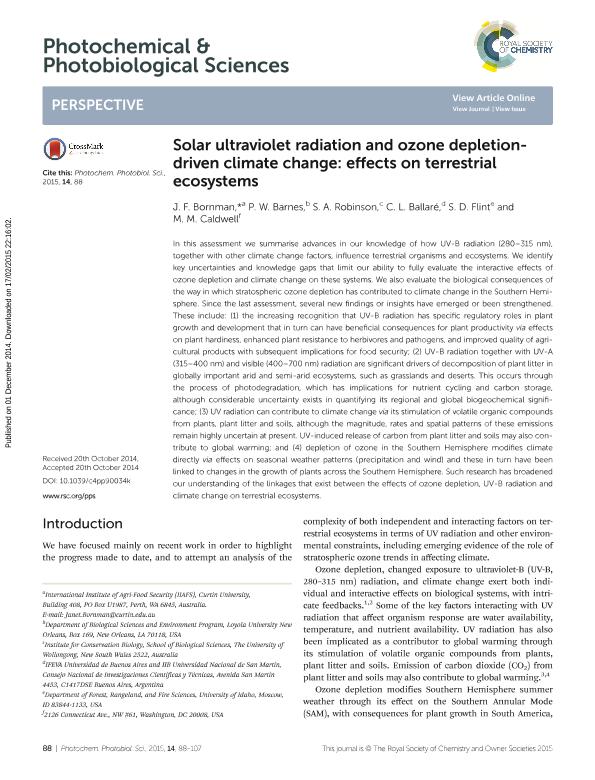Mostrar el registro sencillo del ítem
dc.contributor.author
Bornman, J. F.
dc.contributor.author
Barnes, P. W.
dc.contributor.author
Robinson, S. A.
dc.contributor.author
Ballare, Carlos Luis

dc.contributor.author
Flint, S. D.
dc.contributor.author
Caldwell, M. M.
dc.date.available
2016-02-22T17:21:38Z
dc.date.issued
2015-01
dc.identifier.citation
Bornman, J. F.; Barnes, P. W.; Robinson, S. A.; Ballare, Carlos Luis; Flint, S. D.; et al.; Solar ultraviolet radiation and ozone depletion-driven climate change: effects on terrestrial ecosystems; Royal Society of Chemistry; Photochemical and Photobiological Sciences; 14; 1; 1-2015; 88-107
dc.identifier.issn
1474-905X
dc.identifier.uri
http://hdl.handle.net/11336/4344
dc.description.abstract
In this assessment we summarise advances in our knowledge of how UV-B radiation (280-315 nm), together with other climate change factors, influence terrestrial organisms and ecosystems. We identify key uncertainties and knowledge gaps that limit our ability to fully evaluate the interactive effects of ozone depletion and climate change on these systems. We also evaluate the biological consequences of the way in which stratospheric ozone depletion has contributed to climate change in the Southern Hemisphere. Since the last assessment, several new findings or insights have emerged or been strengthened. These include: (1) the increasing recognition that UV-B radiation has specific regulatory roles in plant growth and development that in turn can have beneficial consequences for plant productivity via effects on plant hardiness, enhanced plant resistance to herbivores and pathogens, and improved quality of agricultural products with subsequent implications for food security; (2) UV-B radiation together with UV-A (315-400 nm) and visible (400-700 nm) radiation are significant drivers of decomposition of plant litter in globally important arid and semi-arid ecosystems, such as grasslands and deserts. This occurs through the process of photodegradation, which has implications for nutrient cycling and carbon storage, although considerable uncertainty exists in quantifying its regional and global biogeochemical significance; (3) UV radiation can contribute to climate change via its stimulation of volatile organic compounds from plants, plant litter and soils, although the magnitude, rates and spatial patterns of these emissions remain highly uncertain at present. UV-induced release of carbon from plant litter and soils may also contribute to global warming; and (4) depletion of ozone in the Southern Hemisphere modifies climate directly via effects on seasonal weather patterns (precipitation and wind) and these in turn have been linked to changes in the growth of plants across the Southern Hemisphere. Such research has broadened our understanding of the linkages that exist between the effects of ozone depletion, UV-B radiation and climate change on terrestrial ecosystems.
dc.format
application/pdf
dc.language.iso
eng
dc.publisher
Royal Society of Chemistry

dc.rights
info:eu-repo/semantics/openAccess
dc.rights.uri
https://creativecommons.org/licenses/by/2.5/ar/
dc.subject
Uv-B
dc.subject
Climate Change
dc.subject
Ecosystem
dc.subject.classification
Ecología

dc.subject.classification
Ciencias Biológicas

dc.subject.classification
CIENCIAS NATURALES Y EXACTAS

dc.title
Solar ultraviolet radiation and ozone depletion-driven climate change: effects on terrestrial ecosystems
dc.type
info:eu-repo/semantics/article
dc.type
info:ar-repo/semantics/artículo
dc.type
info:eu-repo/semantics/publishedVersion
dc.date.updated
2016-03-30 10:35:44.97925-03
dc.journal.volume
14
dc.journal.number
1
dc.journal.pagination
88-107
dc.journal.pais
Reino Unido

dc.journal.ciudad
Cambridge
dc.description.fil
Fil: Bornman, J. F.. Curtin University. International Institute of Agri-Food Security; Australia
dc.description.fil
Fil: Barnes, P. W.. Loyola University. Department of Biological Sciences and Environment Program; Estados Unidos
dc.description.fil
Fil: Robinson, S. A.. University of Wollongong. School of Biological Sciences. Institute for Conservation Biology; Australia
dc.description.fil
Fil: Ballare, Carlos Luis. Consejo Nacional de Investigaciones Científicas y Técnicas. Oficina de Coordinación Administrativa Parque Centenario. Instituto de Investigaciones Fisiológicas y Ecológicas Vinculadas a la Agricultura; Argentina
dc.description.fil
Fil: Flint, S. D.. University of Idaho. Department of Forest, Rangeland, and Fire Sciences; Estados Unidos
dc.description.fil
Fil: Caldwell, M. M..
dc.journal.title
Photochemical and Photobiological Sciences

dc.relation.alternativeid
info:eu-repo/semantics/altIdentifier/url/http://pubs.rsc.org/en/Content/ArticleLanding/2015/PP/C4PP90034K#!divAbstract
dc.relation.alternativeid
info:eu-repo/semantics/altIdentifier/url/http://dx.doi.org/DOI:10.1039/C4PP90034K
dc.relation.alternativeid
info:eu-repo/semantics/altIdentifier/issn/1474-905X
Archivos asociados
